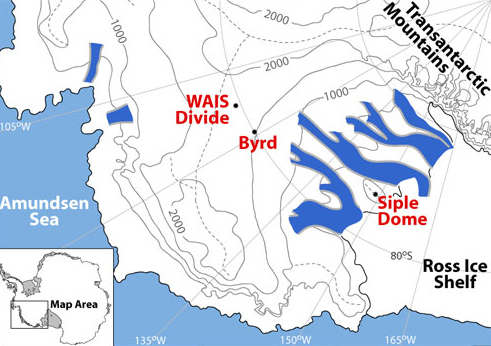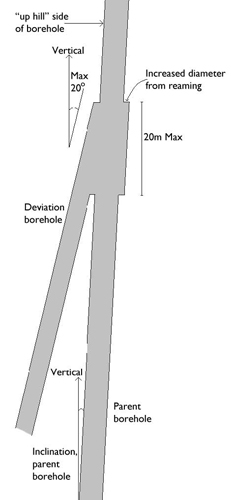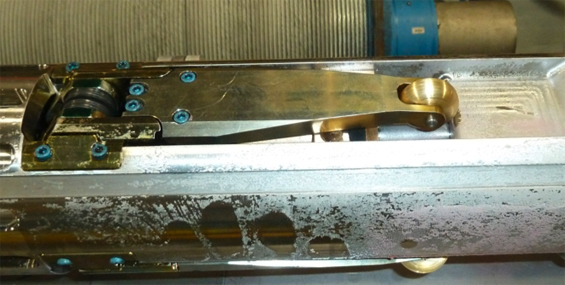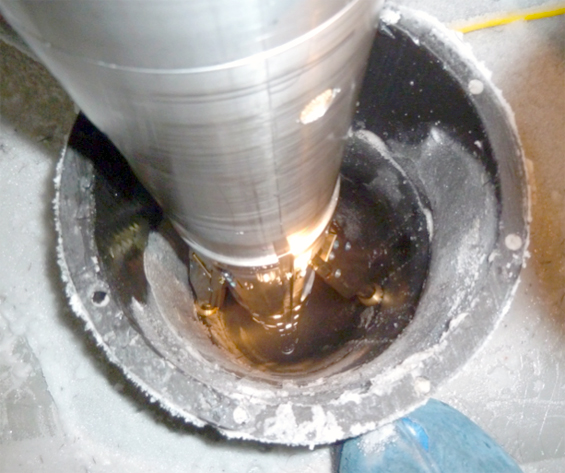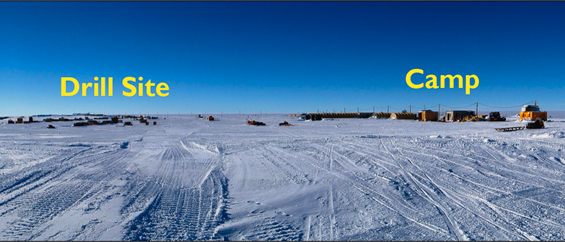IDDO’s Replicate Ice Coring Drill Provides Spectacular Footage (and a Gateway to Excellent Science)
Deep within ice sheets in the Polar Regions is an archive of evidence about the history of our planet’s climate. At the West Antarctic Ice Sheet (WAIS) Divide site, a cold area where the abundant snowfall rarely melts, the ice contains tens of thousands of years of annual information about past climate. By examining cores acquired from specific depths in the ice sheet, depths that include times of abrupt climate change in the past, scientists are investigating thousands of years of greenhouse gas records and other evidence from the ice that will help to understand why and how abrupt changes occur.
Significant innovations by SSEC’s Ice Drilling Design and Operations (IDDO) team on their state-of-the-art Replicate Coring System enable researchers to retrieve additional ice cores from specific depths, without the time and expense of drilling a new hole.
Incredible footage of the drill’s journey two miles beneath the surface was obtained with a specially designed, pressure-resistant video camera attached to the front of the drill.
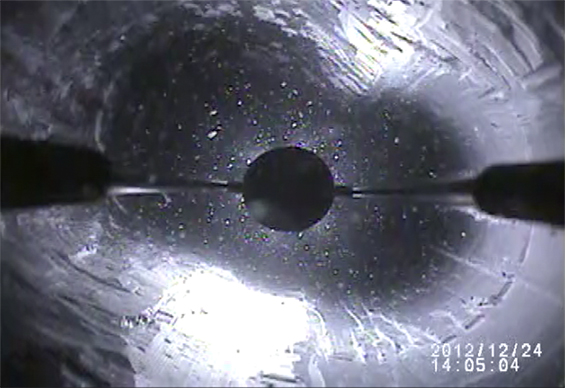
A video camera attached to the replicate drill sonde provides this image of the parent hole (left) and the first deviation off of this hole (right) at a depth of nearly two miles.
Click the image to see the YouTube video of the drill’s operation and descent.
The Replicate Coring technique was developed and tested by the IDDO engineers as part of the Deep Ice Sheet Coring (DISC) Drill. The design of the DISC Drill was started by the IDDO team in 2002 in response to the desire of the US science community for a deep coring drill that would incorporate the ability to retrieve additional cores from deviations from the main borehole. The DISC Drill was put into service at WAIS Divide during the 2007-08 Antarctic field season and completed the main borehole during 2011- 12 reaching a depth of 3,405 meters – an American record.
The IDDO engineers designed actuators that were placed along the shaft of the drill and which apply lateral pressure against the side of the borehole, slightly altering the orientation of the drill head. A new borehole is started and, within about 30 meters of drilling, becomes a unique and separate path. Each actuator arm can push out up to 200 pounds, providing the thrust for the creation of the second path. The samples are taken on the uphill side and parallel to the main borehole, a unique and significant advance in ice core drilling and acquisition.
“The actuators enable us to exit the borehole on the uphill side,” SSEC Engineer Nicolai Mortensen says. “We can work counter to the pull of gravity and then be able to use the path deviation again and again to collect more samples.”
If a scientist desires additional ice from the same depth for continued study, the replicate drill can supply as many as five separate holes for more coring. It is designed to collect 200m of core in a single season from essentially the same depth.
Jay Johnson, the Lead Drilling Engineer for the endeavor says, “There was a bit of uncertainty after we drilled the first replicate core whether we had actually recovered it in the core barrel. After waiting a half hour for the drill to return to the surface from 3002.6m, the drill team and core handlers assembled in the drill arch were dead silent as we watched the drill tower tilt and waited for the first glimpse into the drill head. A loud cheer erupted at the sight of the core! It was a surreal moment for the drill team and especially for the IDDO engineers, Nicolai Mortensen, Chris Gibson, and myself, who developed the technology and hardware for the world’s first robotic ice coring drill. This is truly an engineering marvel and a new chapter in ice core drilling that will lead to new scientific discoveries.”
Some progress updates from the 2012-2013 season (from “Progress Situation Reports” prepared by Kristina Dahnert):
FIRST REPLICATE CORE RECOVERED on Monday, 17 December 2012.
Coring continued and the first deviation was completed on 24 December 2012. Depth of the first deviation was from 3001.549 meters (driller’s depth) to 3100.256 meters for a total of 98.7 meters collected.
The drill was tilted using the initial angle method and was run up and down several times between 2416.2 meters to 2416.7 meters in order to obtain the highest angle possible. Coring was then resumed and the first full diameter core of the second deviation was drilled on Monday, 31 December 2012.
Completed the second deviation on Sunday, 06 January 2013 at a depth of 2469.488m.
The first core of the third deviation was drilled on Tuesday, 08 January 2013. The core was 0.7 meters long and displayed broaching cut marks on the inside of the crescent.
When video footage verified that the 3B deviation had fully diverged from the parent hole, coring with a 1-meter core barrel and two screen configuration was initiated at a depth of 2223 meters and the deviation had fully diverged from the parent by 2242.76 meters.
Deviation #4 was completed on Tuesday, 22 January 2013, at a driller’s depth of 2000.203 meters A total of 48.203 meters of core were collected from this deviation.
The first core of deviation #5 was collected on Thursday, 24 January 2013.
The final core of deviation #5 and of the 2012-2013 season was collected on Saturday, 26 January 2013. The final depth of the deviation was 2428.74 meters (approximately 1.5 miles down).
“A stupendous accomplishment!” says Charlie Bentley, professor emeritus and the P.I. of IDDO. “The IDDO engineers have succeeded at a feat that presented many difficulties, all of which they have overcome by dedication, ingenuity, skill, and just plain hard work. They have broken new ground in the ice coring business with the first directed deviation from a main borehole with a suspended electromechanical drill. This opens a new door for the future of ice core drilling. Our heartiest congratulations go to the whole IDDO crew at WAIS Divide.”
Don Lebar, IDDO Program director says, “The realization of replicate coring at WAIS Divide has been the result of a lot of ingenuity and hard work by the staff of IDDO. The success of the effort to retrieve replicate cores was far from certain and was only possible because of the interest and confidence in the project and IDDO shown by Julie Palais, the NSF Program Manager, Kendrick Taylor, Chief Scientist for the WAIS Divide project, Jeff Severinghaus, Lead Scientist for Replicate Coring, and numerous other scientists interested in ice cores.”
“The Replicate Coring success is the result of a long journey in engineering development, working toward the attainment of very aggressive and sometimes seemingly impossible goals,” says Alex Shturmakov, DISC/Replicate Coring Project Manager of IDDO.
Ice cores drilled in the past have yielded amazing scientific discoveries such as the fact that climate can change abruptly in less than ten years, and that the CO2 in the atmosphere is higher now than evidence from the last 800,000 years shows. For the first time, the IDDO Replicate Drill will provide scientists with multiple ice cores from specifically targeted depths and directions in the ice sheet.
On-site drilling operations at the WAIS divide are led by Jay Johnson and Kristina Dahnert. Other IDDO staff providing support on the ice include:
- Patrick Cassidy
- Dave Ferris
- Chris Gibson
- Jason Goetz
- Josh Goetz
- Mike Jayred
- Nicolai Mortensen
- Elizabeth Morton
- Tanner Kuhl
Congratulations to the IDDO team for a racking up another tremendous accomplishment.

